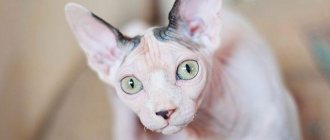Description. How to choose?
The body shape of such fish is oval and elongated in length, and it is also slightly flattened on the sides. The fish is not large, its average length is 6 cm, females are slightly smaller.
The pectoral fins have a pointed shape, while the dorsal and caudal fins have a rounded shape. Males have more developed fins than females. The color of the fish is usually dark brown with green spots, but in the aquarium the richness of color of these fish is unparalleled.
Breeders have bred more than 70 species of such representatives, differing in color and shape of fins. In the aquarium you can see different options of emerald, red, black and pink tones.
Reference! Depending on the shape and size of the fins, there are more than ten types of aquarium bettas. For example, crown-tailed, double-tailed, delta-tailed.
Wherever you buy a betta, you should pay attention to the conditions in which it is kept in the aquarium. It should be spacious so that the fish can swim freely. Keeping it in a jar or plastic container for a long time leads to a state of stress. The water in the aquarium should be clear.
It is best to buy young representatives of this species. Males at this age do not have such luxurious fins as adults, but it is easier for young ones to adapt to new living conditions.
The good appearance of individuals also indicates health and proper maintenance. They should not have torn fins, veils over their eyes, or ruffled scales. They should be active and show interest in the food.
What to do if your fish are unwell
In the first case, there is a bacterial or fungal disease, and this is, in fact, the most dangerous and undesirable case. If this has happened, and we are dealing with an infection that has affected your aquarium, or a certain type of its inhabitants, our actions will be as follows.
First of all, you need to catch the sick fish and move it to another container with water for quarantine and observation. While noting external problems, we do not ignore behavioral changes in our patient’s everyday life. All observations should be written down and, already armed with this knowledge, you can seek help from a specialist who will prescribe treatment.
If the state of our affairs fits the description of the second point of the conditional symptomatic scale, then most likely the problem here lies in the unsatisfactory condition of the aquarium water. In this case, you just need to change the water, and you can also analyze its composition, since there is a possibility of an imbalance in the content of the same ammonia in the water.
Speaking about the suspicious behavior of, say, just one, his excessive anxiety or passivity, there may be either a banal temporary ailment or early symptoms of more complex problems. In this case, the cockerel should also be quarantined for a while for further observations.
Regarding passivity, if we see that the cockerel is lying on the bottom of the aquarium, especially on its side, this is bad. Cockerels sleep differently; this species is characterized by sleeping in a “floating” state, without touching the bottom.
In a word, observation and observation again. A timely response to early signs of the disease significantly increases the chances of a speedy recovery. These are the recommendations for the third item on the symptom scale.
So how long do betta fish live and what can shorten their lifespan?
This extremely dangerous bacterial disease is the most common ailment among other diseases of cockerels. This terrible disease affects the fin system of the fish, leading to the breakdown of connective tissues, and if the intervention is not timely, the betta dies. The infection is caused by a number of bacterial species, mainly pseudomonas and aeromonas.
The symptoms of this disease are obvious and can be easily checked by eye. First, the disease affects the edges of the fins, then the destruction moves deeper, turning a beautiful fin into a kind of rotten, torn rag.
In this case, the affected fin of the fish becomes cloudy in color, and small ulcers can be seen, which are the result of putrefactive processes. The cockerel lies on the bottom, often rubs against the walls of the aquarium, and makes a bad visual impression.
Thus, if we see that our cockerel’s tail and fins have peeled off, he looks bad and has lost his appetite, the conclusion about the disease suggests itself.
Fin rot in bettas can most often be caused by the unsatisfactory condition of the aquarium, which creates excellent conditions for the growth of bacteria. Reasons may include untimely change of water in the tank, insufficient water filtration, or the introduction of new residents infected with such an infection into the aquarium.
If a cockerel has contracted pseudomonosis, a combination of antibiotics and antifungal agents is used for treatment, the purpose of which is to prevent the proliferation of bacteria in the affected areas as quickly as possible, which will later make it possible, having already extinguished the foci of the disease, to finish off, as they say, its remains. Among the drugs offered, we will primarily mention Antibak, Doxycycline, Sulfur Baktopur, Bicillin 5.
The sick fish is quarantined. As a preventative measure, we continue to monitor the condition of the aquarium and change the water, algae and soil on time.
Another fairly common disease, also quite dangerous, especially if it is neglected. The causative agent of oodiniosis is a microscopic parasite, the flagellate Oodinium limneticum, which parasitizes the outer skin of fish.
The main symptoms of this disease are easily visible to the eye, and they are as follows. The body of the fish changes its color, acquiring a dirty yellow tint due to the appearance of a gray coating on the body and fins, which is why the disease is also called “velvet disease” or “velvet disease”.
It must be said that in the initial stage of the disease the cockerel does not lose its appetite, and traditionally requires eating at the time at which feeding usually occurs. Therefore, at the beginning of a betta’s illness, the fish’s normal appetite means nothing.
If oodiniosis is not treated in time, the parasite will continue its work and the fish will become worse day by day. Appetite will disappear, skin corrosion will force your pet to constantly rub against the walls of the tank, traditional mobility will be replaced by apathy. A sick fish can lie on the bottom for a long time, even leading to death. And in this state, when the cockerel does not eat or swim, the time to the end is already calculated in days and it is simply impossible to delay any longer.
To prevent this, we follow a proven scheme of isolating the sick individual from the rest of the inhabitants of the aquarium, while the water in the quarantine pond should be slightly warmer than usual, about 25 degrees will be just right. Next comes drug treatment.
Among the remedies, we highlight proven antibiotics:
- Sulfur Omnipur;
- Sulfur oodinopur.
Also effective are agents such as Oodinol or Ichthyofor.
Another infectious disease, by the way, one of the most common among all freshwater fish. Its causative agents are 2 types of bacteria, namely: Ichtyophtirius multifiliis and Cryptocaryon irritans.
This extremely dangerous disease does not bypass and
, affecting the skin and strewing the fish with small whitish “semolina” grains, hence the second name of the disease. The incubation period usually lasts about 5 days. The disease itself can last up to two weeks and the result, if there is no response from the careless owner of the aquarium, will be disastrous.
Among the causes of the disease, we highlight possible overfeeding of males, overcrowding of the tank, its pollution, stagnation of water, which affects the condition of the fish’s eyes.
We carry out treatment using medications containing malachite green.
We include these:
- Malachite green;
- Sulfur Protazol;
- Antipar.
We also apply extended quarantine for up to a month.
Dropsy or ascites
This disease occurs with a very characteristic clinical picture, which is difficult to confuse with another disease of cockerels. The bulging eyes of a fish indicate the presence of ascites in your pet as clearly as the bulging abdomen of an overfed betta.
We suggest you read: How much does an Indian duck cost live? || How much does an Indian duck cost?
After all, exceeding the healthy daily food intake is one of the reasons that the fish is “swollen” and its tummy is bulging. And you shouldn’t assume that if with these symptoms
lies on the bottom, he is just sleeping.
It is the impaired metabolism, along with infection by the fungus Ichthyosporidium, that are the two main causes of dropsy. This disease is difficult to tolerate by fish and can be successfully treated only in the early stages. Most often, ascites ends in death, so we do not lose our vigilance.
For treatment the following are used:
- Sera Baktopur direct;
- Sulfur Ectopur;
- Furan-2.
Until the symptoms subside, especially for eye problems, we under no circumstances weaken the treatment.
Lifespan
The betta fish is a famous aquarium inhabitant that is loved by many people due to its temperament and bright disposition. Its average lifespan in an aquarium is 3–4 years with proper maintenance and nutrition. Some pets can live longer, it depends on the conditions created by the owner.
Reference! If you have betta fish in your aquarium, you should treat their maintenance responsibly, as they need the attention and care of the owner.
How to determine how old a fish is?
Sellers in pet stores cannot always tell how old these types of fish are. Determining age on your own is problematic, but using the tips below, you can give an approximate estimate:
- Determine age by size. The closer the fish is to its optimal size, the older it is. For example, if you buy a rooster 4 cm long, then it is still a young individual.
- Determine age by external signs. Adult representatives have large fins.
- Determine age by color. With age, the color of the fish fades, so older representatives are very different from their younger relatives.
How long can a betta fish live in an aquarium without oxygen?
The betta fish absorbs atmospheric air, floats to the surface from time to time, swallows a bubble of air, from which it extracts oxygen. Such representatives are not demanding in terms of care, but cleanliness must be maintained. Three liters of water will be enough for one fish.
Reference! They are often purchased as a single aquarium pet. But algae, grottoes and good lighting in the aquarium will make their life more joyful.
Water changes should be carried out as in the case of other types of fish:
- at least once every seven days;
- If the aquarium has a volume of up to five liters, then fresh water should be added a couple of times a week.
Choosing decor and plants
The soil for a small aquarium consists of beautiful multi-colored pebbles. And preferably artificial ones. Why? Because it is necessary to clean the natural soil. How to do this in such a small volume? Artificial stones are simple in that they can simply be washed.
We suggest you read: Rhinitis in cats: symptoms and treatment. How to treat a runny nose in a cat at home: what to do, drops to treat a runny nose
If the aquarium is equipped with both a filter and a heater, if it is large enough and good enough, then you can think about live plantings. And several decorations. When we are talking about a small volume of a fish house, then you should not displace the already small volume of water with numerous decorations. The cockerel, in principle, does not need them at all. As for plants, artificial ones look no worse than natural ones.
How to properly maintain it so that it lives longer?
Her life expectancy is influenced by many factors:
- Environment - pets must be placed in a pre-prepared aquarium, otherwise they will live for several days. Vegetation is planted in the container to produce oxygen and for the fish to snack on the algae.
- Nutrition - cockerels are omnivores, but special attention must be paid to feeding: meals should be regular and the amount of food should be moderate.
- Equipment - a filter for water purification and a heater in the aquarium are required.
- Neighborhood - in order for representatives of this species to live longer, you need to select the right neighbors for them.
- the water temperature in the aquarium from 26 to 29 degrees Celsius.
Adverse factors that shorten life
Many factors negatively affect life expectancy:
- Small aquarium volume . Individuals of this species need to constantly move; there is no need to put them in tight containers that limit their activity.
- Lack of plants in the aquarium . Fish need oxygen, which comes from algae.
- Rare aquarium cleaning . The water in it should be changed periodically, food residues and rotting plants should be removed.
- Lack of conditions for spawning . Cockerels cannot be called exemplary parents, but the inability to reproduce negatively affects their health and reduces life expectancy.
- Diseases . The most common ailments that can shorten life include dropsy and fin rot.











